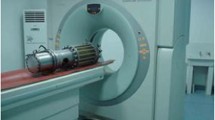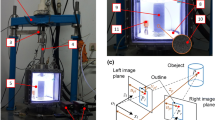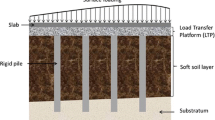Through CT scanning, digital image processing, reverse engineering reconstruction, and 3D meshing, the numerical model of the mixed soil was established. On this basis, a numerical simulation of the triaxial testing was carried out. The movement of the 70 gravels was monitored and analyzed based on the proposed geometric feature point method (GFPM). The interaction between the gravels and soil during the triaxial testing was explained according to the spatial attitude of the gravels. The top gravels showed a dominant detachment with soil in the axial direction and an increasing detachment in the lateral direction. The gravels close to the side face of the triaxial specimen showed a dominant detachment in the lateral direction. The gravels rotated during the triaxial shearing process. The deformation of the gravel-soil interfaces near the shear zone was more significant. At the bottom of the specimen, the gravel-soil interface had no obvious deformation.
Similar content being viewed by others
References
R. J. Tan, R. L. Hu, and W. J. Xu, “Some geomechanical properties of soil-rock mixtures in the Hutiao Gorge area, China,” Geotechnique, 57(3), 255-264 (2007).
S. Sun, P. Xu, and J. Wu, “Strength parameter identification and application of soil-rock mixture for steep-walled talus slopes in southwestern China,” Bull. Eng. Geo Environ., 73(1), 123-140 (2014).
W. J. Xu, Q. Xu, and R. L. Hu, “Study on the shear strength of soil-rock mixture by large scale direct shear test,” J. Rock Mech. Min Sci., 48(8), 1235-1247 (2011).
W. J. Xu, Z. Q. Yue, and R. L. Hu, “Study on the mesostructure and mesomechanical characteristics of the soil-rock mixture using digital image processing based finite element method,” J. Rock Mech. Min Sci, 45(5), 749-762 (2008).
W. J. Xu, L. M. Hu, and W. Gao, “Random generation of the meso-structure of a soil-rock mixture and its application in the study of the mechanical behavior in a landslide dam,” J. Rock Mech. Min Sci, 86, 166-178 (2016).
Y. Wang and X. Li, “Experimental study on cracking damage characteristics of a soil and rock mixture by UPV testing”, Bull. Eng. Geol. Environ., 74(3), 775-788 (2015).
J. Gong and J. Liu, “Analysis on the Mechanical Behaviors of Soil-rock Mixtures Using Discrete Element Method,” Procedia Eng., 102, 1783-1792 (2015).
G. W. Cheng, H. E. Jian-Ming, and L. Xiao, “Particle Flow Simulation for Soil-rock Mixtures under Biaxial Pressure,” Min Met. Eng. (2010).
R. T. Donaghe and V. T. Iii, “Proposed New Standard Test Method for Laboratory Compaction Testing of Soil-Rock Mixtures Using Standard Effort,” Geotech. Test. J., 17(3), 387-392 (1994).
D. L. Brakensiek and W. J. Rawls, “Soil containing rock fragments: effects on infiltration,” Catena, 23(1-2), 99-110 (1994).
H. Jia, C. Chen, and H. Zhang, “Application of CT and DC electromagnetic wave in geological investigation engineering in the suburb mountains,” Geotech. Invest. Surv., 2013.
V. Cnudde and M. N. Boone, “High-resolution X-ray computed tomography in geosciences: A review of the current technology and applications,” Earth-Science Rev., 123(4), 1-17 (2013).
R. A. Ketcham and W. D. Carlson, “Acquisition, optimization and interpretation of X-ray computed tomographic imagery: applications to the geosciences,” Comput. Geosci., 27(4), 381-4003 (2001).
L. B. Wang and J. D. Frost Naga Shashidhar, “Microstructure study of west track mixes from X-ray tomography images,” TRB 80th Annual Meeting, Washington D C, 2001.
H. M. Zelelew and A. T. Papagiannakis, “Wavelet-based characterisation of aggregate segregation in asphalt concrete X-ray computed tomography images,” Int. J. Pavement Eng., 12(6), 553-559 (2011).
C. Jin, X. Yang, and Z. You, “Automated real aggregate modelling approach in discrete element method based on X-ray computed tomography images,” Int. J. Pavement Eng., 2015.
L. Skarzynski, M. Nitka, and J. Tejchman, “Modelling of concrete fracture at aggregate level using FEM and DEM based on X-ray μCT images of internal structure,” Eng. Fract. Mech., 147, 13-35 (2015).
H. F. Sun, Z. K. Yang, and M. X. Xing, “CT Investigation of Fracture Mechanism of Soil-Rock Mixtures,” Appl. Mech. Mater., 204-208(2), 67-71 (2012).
Y. Wang, X. Li, and Y. F. Wu, “Experimental study on meso-damage cracking characteristics of RSA by CT test,” Environ. Earth Sci., 73(9), 5545-5558 (2015).
Y. Wang, C. H. Li, and Y. Z. Hu, “X-ray computed tomography (CT) observations of crack damage evolution in soil-rock mixture during uniaxial deformation,” Arab. J. Geosci., 11(9), 199 (2018).
Y. Wang, C. H. Li, and Y. Z. Hu, “Use of X-ray computed tomography to investigate the effect of rock blocks on meso-structural changes in soil-rock mixture under triaxial deformation,” Construct. Build. Mater., 164, 386-399 (2018).
C. S. Li, D. Z. Hang, and S. S. Du, “Computed tomography based numerical simulation for triaxial test of soil-rock mixture,” Comp.Geotech., 73, 179-188 (2016).
J. L. Junkins and M. D. Shuster, “Geometry of the Euler angles,” J. Astronaut. Sci., 41(4), 531-543 (1993).
P. J. Besl and N. D. Mckay, “A method for registration of 3-D shapes,” IEEE Transa Pattern Anal and Machine Intelli, 14(2),239-256 (1992).
X. Wang, M. M. Zhang, and X. Yu, “Point cloud data registration using improved iterative closest point method,” Optics Precis. Eng., 20(9), 2068-2077 (2012).
J. Liu, X. Zhang, and J. W. Zhu, “ICP three- dimensional point cloud registration based on K- D tree optimization,” Eng. Surv. Map, 25(6), 15-18 (2016).
H. Y. Zhang, W. J. Xu, and Y. Z. Yu, “Triaxial tests of soil-rock mixtures with different rock block distributions,” Soils Found., 56(1), 44-56 (2016).
J. Rucknagel, P. Gotze, and B. Hofmann, “The influence of soil gravel content on compaction behaviour and pre-compression stress,” Geoderma, 209-210(11), 226-232 (2013).
E. Perfect and B. D. Kay, “Statistical characterization of dry aggregate strength using rupture energy,” Soil Sci. Soc. Am. J., 58, 1804-1809 (1994).
E. Perfect, Q. Zhai, and R. L. Blecins, “Estimation of Weibull brittle fracture parameters for heterogeneous materials,” Soil Sci. Soc. Am J., 62(5), 1212 1219 (1998).
L. Munkholm and E. Perfect, “Brittle fracture of soil aggregates: Weibull models and methods of parameters estimation,” Soil Sci. Soc. Am J., 69, 1565-1571 (2005).
Author information
Authors and Affiliations
Corresponding author
Additional information
Translated from Osnovaniya, Fundamenty i Mekhanika Gruntov, No. 2, p. 30, March-April, 2020.
Rights and permissions
About this article
Cite this article
Zheng, B., Zhang, D., Wang, G. et al. The Behavior of Gravel-Soil Interface During Triaxial Testing of the Mixed Soil. Soil Mech Found Eng 57, 147–154 (2020). https://doi.org/10.1007/s11204-020-09650-7
Published:
Issue Date:
DOI: https://doi.org/10.1007/s11204-020-09650-7




